The Bulldozer Review: AMD FX-8150 Tested
by Anand Lal Shimpi on October 12, 2011 1:27 AM ESTThe Test
To keep the review length manageable we're presenting a subset of our results here. For all benchmark results and even more comparisons be sure to use our performance comparison tool: Bench.
| Motherboard: |
ASUS P8Z68-V Pro (Intel Z68) ASUS Crosshair V Formula (AMD 990FX) |
| Hard Disk: |
Intel X25-M SSD (80GB) Crucial RealSSD C300 |
| Memory: | 2 x 4GB G.Skill Ripjaws X DDR3-1600 9-9-9-20 |
| Video Card: | ATI Radeon HD 5870 (Windows 7) |
| Video Drivers: | AMD Catalyst 11.10 Beta (Windows 7) |
| Desktop Resolution: | 1920 x 1200 |
| OS: | Windows 7 x64 |
Windows 7 Application Performance
3dsmax 9
Today's desktop processors are more than fast enough to do professional level 3D rendering at home. To look at performance under 3dsmax we ran the SPECapc 3dsmax 8 benchmark (only the CPU rendering tests) under 3dsmax 9 SP1. The results reported are the rendering composite scores.

As our first heavily threaded, predominantly FP workload we see the FX-8150 come out swinging. A tangible upgrade from the Phenom II X6, the 8150 is hot on the heelds of the Core i5 2400, however it is unable to compete with the 2500K and 2600K.
Cinebench R10 & 11.5
Created by the Cinema 4D folks we have Cinebench, a popular 3D rendering benchmark that gives us both single and multi-threaded 3D rendering results.
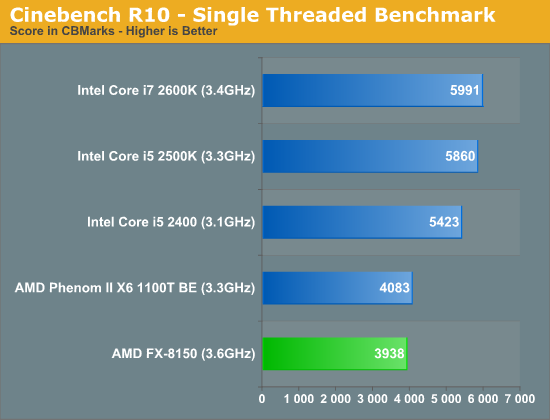
As I alluded to earlier, single threaded performance is going to be a bit of a disappointment with Bulldozer and here you get the first dose of reality. Even considering its clock speed and Turbo Core advantage, the FX-8150 is slower than the Phenom II X6 1100T. Intel's Core i5 2500K delivers nearly 50% better single threaded performance here than the FX-8150.
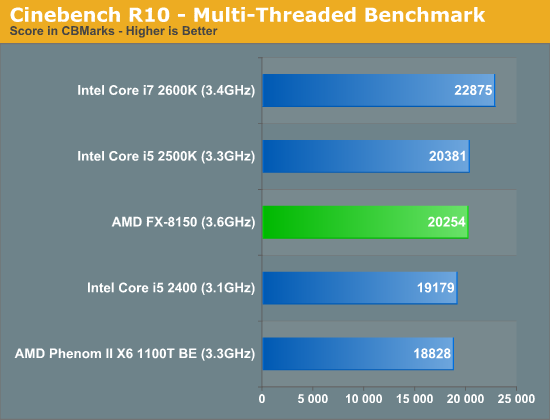
Crank up the threads and the FX-8150 shines, finally tying the 2500K at a comparable price point.
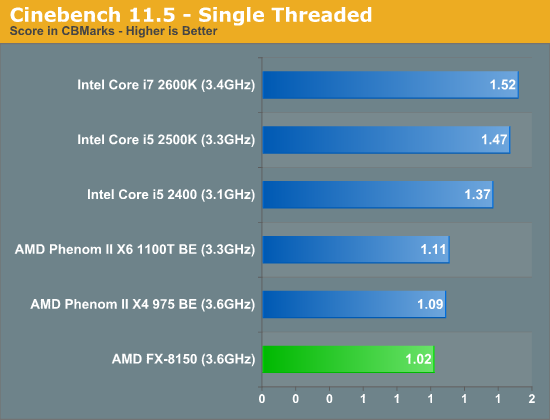
Even with more modern workloads, the FX-8150 isn't able to compete in single threaded speed. Here the 2500K is 44% faster.
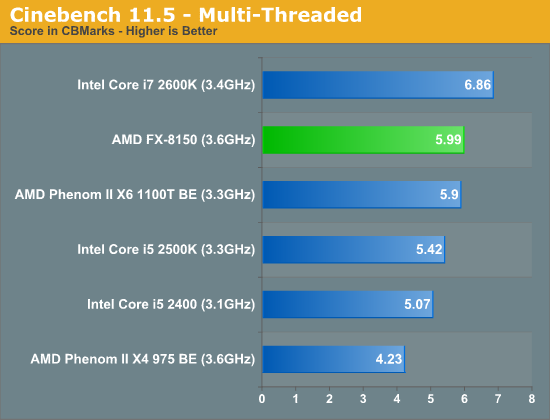
Modern multithreaded workloads however do quite well on Bulldozer. The gains over the old Phenom II X6 1100T are unfortunately not as large as we would expect them to be.
7-Zip Benchmark
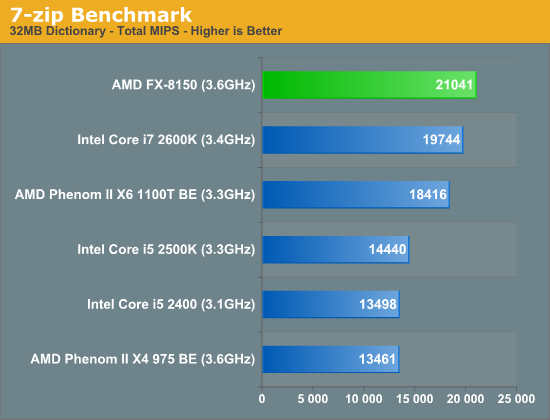
Heavily threaded workloads obviously do well on the FX series parts, here in our 7-zip test the FX-8150 is actually faster than Intel's fastest Sandy Bridge.
PAR2 Benchmark
Par2 is an application used for reconstructing downloaded archives. It can generate parity data from a given archive and later use it to recover the archive
Chuchusoft took the source code of par2cmdline 0.4 and parallelized it using Intel’s Threading Building Blocks 2.1. The result is a version of par2cmdline that can spawn multiple threads to repair par2 archives. For this test we took a 708MB archive, corrupted nearly 60MB of it, and used the multithreaded par2cmdline to recover it. The scores reported are the repair and recover time in seconds.
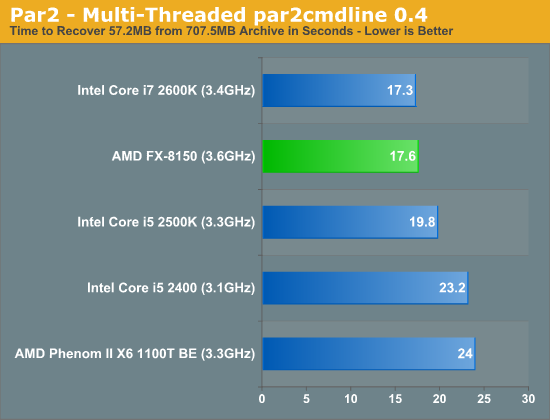
Once again, throw more threads at the processor and the FX-8150 can outperform the Core i5 2500K.
TrueCrypt Benchmark
TrueCrypt is a very popular encryption package that offers full AES-NI support. The application also features a built-in encryption benchmark that we can use to measure CPU performance with:
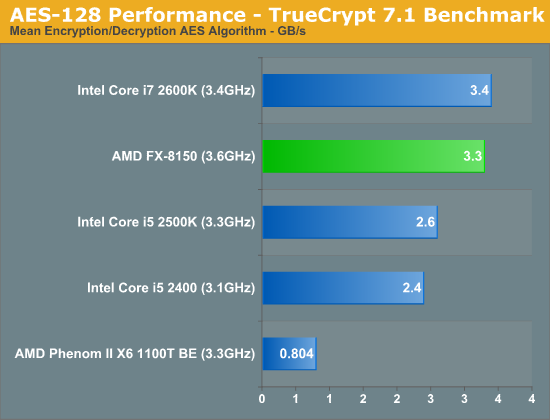
Bulldozer adds AES-NI acceleration, a feature that wasn't present in the Phenom II X6. As a result the FX-8150 is among the fastest at real time AES encryption/decryption, second only to the 2600K. Intel's artificial segmentation using Hyper Threading comes back to haunt it here as the 2500K is significantly slower than the 8-threaded beast.
x264 HD 3.03 Benchmark
Graysky's x264 HD test uses x264 to encode a 4Mbps 720p MPEG-2 source. The focus here is on quality rather than speed, thus the benchmark uses a 2-pass encode and reports the average frame rate in each pass.
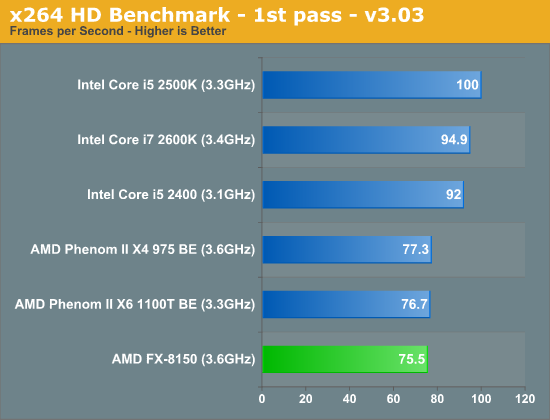
As I mentioned earlier, the first pass of our x264 HD benchmark is a lightly threaded task. As such, the FX-8150 doesn't do very well here. Even the old Phenom II is able to inch ahead of AMD's latest. And Sandy Bridge obviously does very well.

The second pass is more thread heavy, allowing the FX-8150 to flex its muscle and effectively tie the 2600K for first place.
AMD also sent along a couple of x264 binaries that were compiled with AVX and AMD XOP instruction flags. We ran both binaries through our x264 test, let's first look at what enabling AVX does to performance:
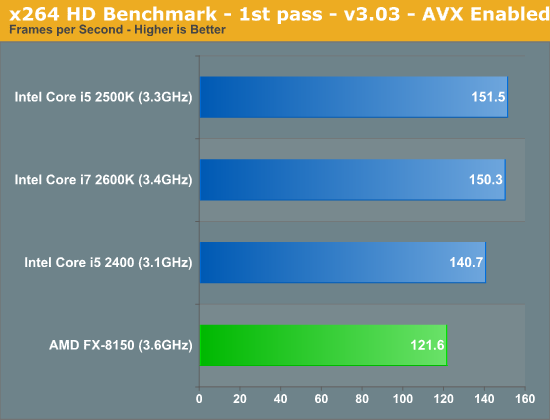
Everyone gets faster here, but Intel continues to hold onto a significant performance lead in lightly threaded workloads.
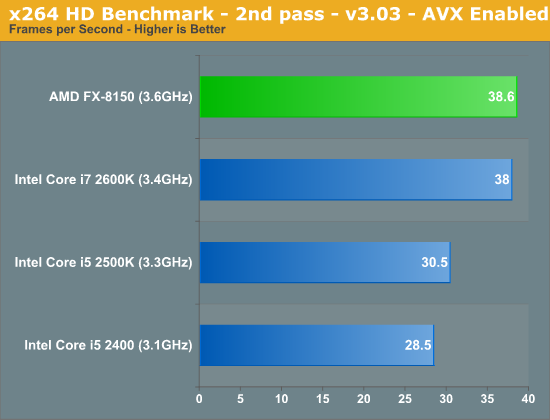
The standings don't change too much in the second pass, the frame rates are simply higher across the board. The FX-8150 is an x86 transcoding beast though, roughly equalling Intel's Core i7 2600K. Although not depicted here, the performance using the AMD XOP codepath was virtually identical to the AVX results.
Adobe Photoshop CS4
To measure performance under Photoshop CS4 we turn to the Retouch Artists’ Speed Test. The test does basic photo editing; there are a couple of color space conversions, many layer creations, color curve adjustment, image and canvas size adjustment, unsharp mask, and finally a gaussian blur performed on the entire image.
The whole process is timed and thanks to the use of Intel's X25-M SSD as our test bed hard drive, performance is far more predictable than back when we used to test on mechanical disks.
Time is reported in seconds and the lower numbers mean better performance. The test is multithreaded and can hit all four cores in a quad-core machine.
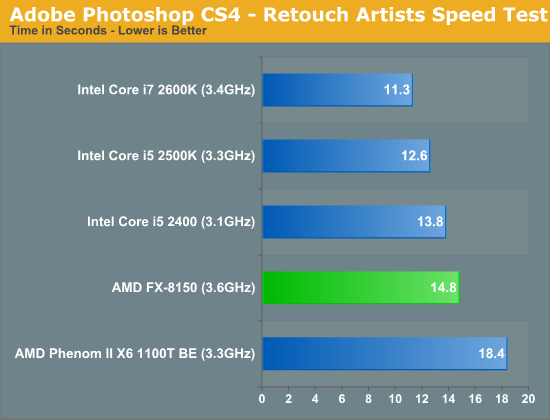
Photoshop performance improves tangibly over the Phenom II X6, unfortunately it's not enough to hang with the enthusiast Sandy Bridge parts.
Compile Chromium Test
You guys asked for it and finally I have something I feel is a good software build test. Using Visual Studio 2008 I'm compiling Chromium. It's a pretty huge project that takes over forty minutes to compile from the command line on a dual-core CPU. But the results are repeatable and the compile process will easily stress more than 8 threads on a CPU so it works for me.
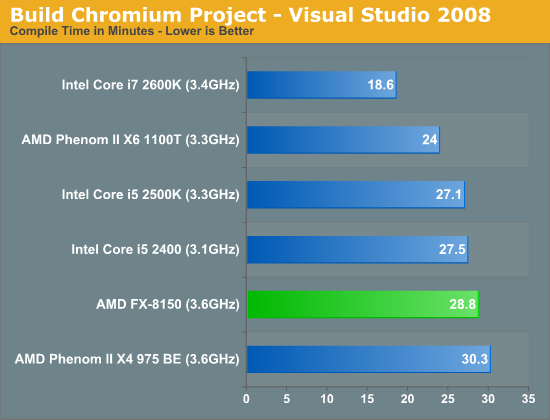
Our compiler test has traditionally favored heavily threaded architectures, but here we found the Phenom II X6 1100T to offer a tangible performance advantage over Bulldozer. While AMD is certainly competitive here, this is an example of one of those situations where AMD's architectural tradeoffs simply don't pay off—not without additional clock speed that is.
Excel Monte Carlo

Our final application test is another win for AMD over the Core i5 2500K. The victory is entirely a result of Intel's Hyper Threading restrictions though, the eight-thread 2600K is able to easily outperform Bulldozer. Either way, AMD delivers better performance here for less money.










430 Comments
View All Comments
Elric42 - Thursday, December 1, 2011 - link
I wanted to say one thing i dont have one but a friend of mine does and he showed me somthing my i5 cant do he was playing a game called crissis if thats how u spell it and running a video editting program at he same time well i cant do that with my i5 if i did the game would start to lag crissis takes alot out of your cpu bad programing even video cards have trouble with the game but bd seems to muti task better then what my i5 can do just wondering if its more for peeps who do alot of stuff at one time.ZyferXY - Monday, January 2, 2012 - link
Thanks for pointing that out because not so long ago i saw a video on amd's web site where they were showing of a amd Llano notebook vs a intel sandy bridge core i7 notebook they started the same benchmark on both notebooks and the intel was quite fast but as they open more and more programs at the same time the intel starts to drop in performance where the amd is running stable. So my suggestion would be to run all benchmark on the bulldozer and i7 2600k again but this time open about 10 or 20 other programs a the same time then u will truly see the bulldozer shine. I am not a amd fanboy my current build a intel Pentium G860 and i am very dissapointed in myself i shouldve gone with the amd q640 it was around the same price when i bought it. My next build will be a Amd FX4100. HAmakaira - Thursday, December 8, 2011 - link
Well I very excitedly bought a 8150 based system for number crunching as the performance/$ looked very good. I could buy a "quiet" system for Aus $ 1130 with SSD and only 8Gb RAM.I had previously purchased a Intel i7 2600K, but could never get it to overclock and run 64 bit Java app (Napoleon Spike from DUG) 24/7, it fell over after 6 hrs or 12 or 23 or 47, it always fell over despite water cooling.
Now the bulk of my work is done by Xeons in the rack, with a couple of dual 5680's systems doing the heavy lifting (2 x 6 core + hyperthreading looks like 24 CPU's to OS). These are good stable systems with 96Gb RAM, but high overall system cost.
I wanted a few cheap and moveable fast CPU's. Boy did the Bulldozer fail to deliver
More is Better measure in Bytes inversion throughput/minute
BD 8150 115-123k in 8/8 threads i.e. flat out
i7 2600 237-268k in 8/8 threads i.e. flat out
Xeon dual 5680 333-356k in 12/24 threads i.e.half loaded
i7-870 166k in 8/8 threads i.e flat out
Xeon Dual E5520 190k 12/16 threads
Xeon Dual 5430 132k 8/8 threads
The Bulldozer is the slowest and the newest....very poor performance. Eclipsed by Intel at similiar price point. I might as well replace the MB and CPU and go with i73960 or 3930...
wepexpert117 - Thursday, December 8, 2011 - link
I dunno if anyone noticed, but if u study the architectures carefully, then what AMD calls as a 'module' is comparable to a 'core' of Intels. Intels Hyperthreading allows two logical thread executions per core. But AMD's TruCore theory, only allows one thread per core. The Intel i5-2500K has 4 physical cores and 8 logical threads. Compared to that the most powerful of the AMD, the FX-8170, contains 4 modules which can execute 8 threads, with 2 cores per module, each core executing 1 thread. On the other hand the i7-2600K contains 6 physical cores and 12 logical threads. Hence by no chance, can the FX-8150, can match the capability of the 2600K, as the latter as 2 more cores to add to the power. As for the results of the benchmarking, it also agrees with the fact that the FX-8150 is comparable albeit a little less powerful than the i5-2500K, because of the architecture difference between Intels core and AMD's Bulldozer.If AMD ever brings out (according to them) a 12 core FX processor (Prob. FX-12XXX), then it would be really interesting to see how that matches with the i7-2600K. Altough the shared L2 cache architecture, is what may be detrimental to the performance of these processors.Jondenmark - Saturday, December 24, 2011 - link
Something is wrong. If I look at a die shot of Llano then the core is about 1½ times the size of the 1 MB L2 cache. If I look at a Bulldozer module, it is about 1½ times the 2 MB L2 cache. To me this indicates, that a Buldozer module is about 100% larger than a phenom II core which is far from the 12% more core size, which AMD has previously indicated was the cost of adding another core to form a module. The 12% was expected to allow AMD to add nearly double the core count on a given process node to convince the server market and give plenty of die space for the GPU on the Llano APU. Where am I wrong and what is right?8 core cpu - Friday, January 6, 2012 - link
This <a herf="http://8corecpu.com/">8 Core Cpu</a> is high spreed CPU. It is best than other CPU8 core cpu - Friday, January 6, 2012 - link
This 8 Core Cpu is high spreed CPU. It is best than other CPU. For more info please ....http://8corecpu.com/
Raven0628 - Saturday, January 14, 2012 - link
I beleive amd realy missed it shoot badly, but it is still the right social choice caus what will happen if intel get x86 monopol and they are still resonably priced and whene you have to live with it in every day life will you realy notice the diferance in perfomance. Unless you realy to go for all the top of the line in every part of your system you will got for the top of intel i7.But i'v never did and alway ended up with reliable good perfomance amd sys for less than 800$ counting with the power supply i had to replace. this year. my point unless you want a death machine go for amd and you will feel better with your self ;).
PS. sry for the terible english.
Ernst0 - Sunday, February 5, 2012 - link
Hey guys.There is no doubt that whatever critiques have been posted are valid but I skimmed a few pages and saw no "Consumer" comments.
I have purchased an 8150 with a AMD3+ motherboard and will be putting the unit together.
In my days since the Z80 and 48k this represents the nicest cpu ever for me.
That it was affordable and that I will have 8 cores to task with my hobby programming such as trying to factor RSA-numbers or the ilk the AMD 8=core is a dream system for the price.
I picked up case, mother board power supply, 1.5 TB drive DVD, 1 gb video, 16 gb ram, 28 inch monitor, wall mount for monitor so I can have two 28's with one the long way for source code and perhaps something else.. Anyway $1200 is the cost.
Now this is my first bare-bones experience too so all in all it is exciting to get such a dream machine and I am happy to step forward and support AMD
I don't know what awaits when the memory arrives and I boot up but it feels like Starship already and I have vowed to learn OpenMP under GCC to advance into multi-core programming.
So perhaps there will be issues. perhaps this is not all that nor is it wat will come but from where I am at I am still on the AMD home team and my money is flowing in the economy.
I went from trs 80 to Amiga then to twin AMD single core chips on one Motherboard, Moved to the early quad cores dreaming of dual quad cores when a system with 8 cores of that day would have cost $4900 and now picked up a system that as a boy in 1973 I would have considered Alien-ufo technology for about what I paid for dual single core chips just a few years ago.
So BullDozer can't be all that bad. The price is good! I will see how she runs. I often peg cores at 100% for days when searching for RSA factors.. Looks like I get more bang for the same bucks this time and I am all for that.
Thank you AMD for such a wonderful cpu. I plan to make use and thanks to the motherboard I can watch out for heat issues much easier than ever,
Not to mention it looks like the sound system is way advanced over the last computer as well.
So from a consumer / hobby programmer point of view this is very cool indeed.
Ernst
mumbles - Sunday, February 12, 2012 - link
Thank you for being the first to actually contribute some real world response to this architecture. So many trolls on this thread that are intel fanboys.Also, if your using xen with this thing, I would be interested in seeing some feedback on how multiple guests(like more than 4) act when trying to fight for floating point processor time. Be interesting also to see if 4 floating point threads and 4 integer threads can all run at the same time with no waiting. That might be asking too much for now tho.